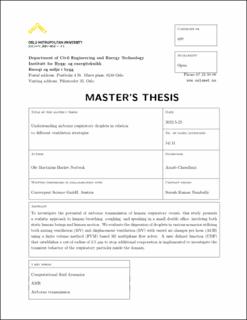| dc.contributor.advisor | Chaudhuri, Chaudhuri | |
| dc.contributor.author | Norbeck, Ole Martinius Harket | |
| dc.date.accessioned | 2022-10-04T08:06:54Z | |
| dc.date.available | 2022-10-04T08:06:54Z | |
| dc.date.issued | 2022 | |
| dc.identifier.uri | https://hdl.handle.net/11250/3023494 | |
| dc.description.abstract | Viral transmissions from human beings has emerged into a hot topic over the past several years as the world
has faced severe repercussions on societies, economies and health following COVID-19. Understanding the
dynamics of respiratory events such as coughing, breathing and speaking remains to be fully understood,
especially in the mode of airborne transmission.
This study presents a realistic approach to human breathing, coughing and speaking in a small double office
considering scenarios involving static human beings as well as human motion. Utilizing a finite volume
method based 3D multiphase flow solver, we assess the dispersion of droplets in various scenarios using both
mixing ventilation (MV) and displacement ventilation (DV) with different air changes per hour (ACH). To
analyze the transient behaviour of the respiratory particles within the domain a user defined function (UDF)
is implemented that defines a cut-of radius of 2.5 μm to cease further evaporation.
In comparison to MV, we detect a clear tendency that DV inhibits the dispersion of respiratory particles at
both high and low ACH. In terms of particle removal, the current conditions make it difficult to determine
which ventilation method is better. To reach a conclusion on the efficiency, more research is required. | en_US |
| dc.language.iso | eng | en_US |
| dc.publisher | OsloMet - storbyuniversitetet | en_US |
| dc.relation.ispartofseries | MAEN;2022 | |
| dc.subject | Airborne transmission | en_US |
| dc.subject | Computational fluid dynamics | en_US |
| dc.title | Understanding airborne respiratory droplets in relation to different ventilation strategies | en_US |
| dc.type | Master thesis | en_US |
| dc.description.version | publishedVersion | en_US |
